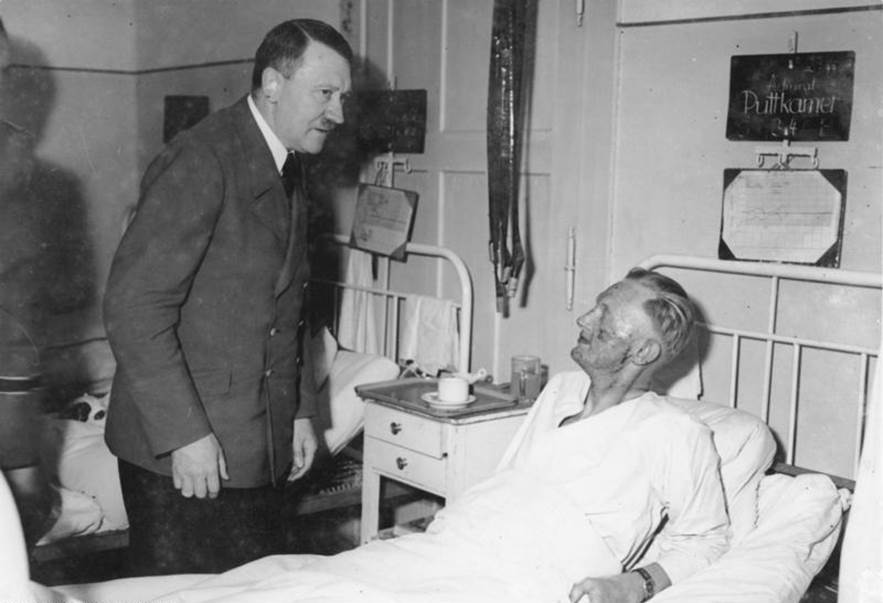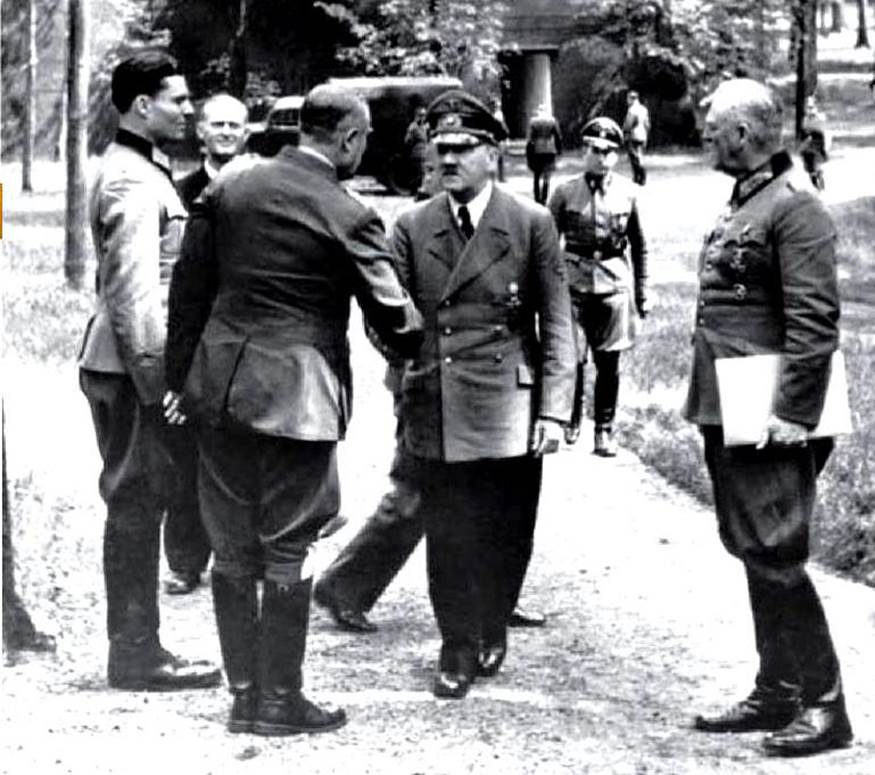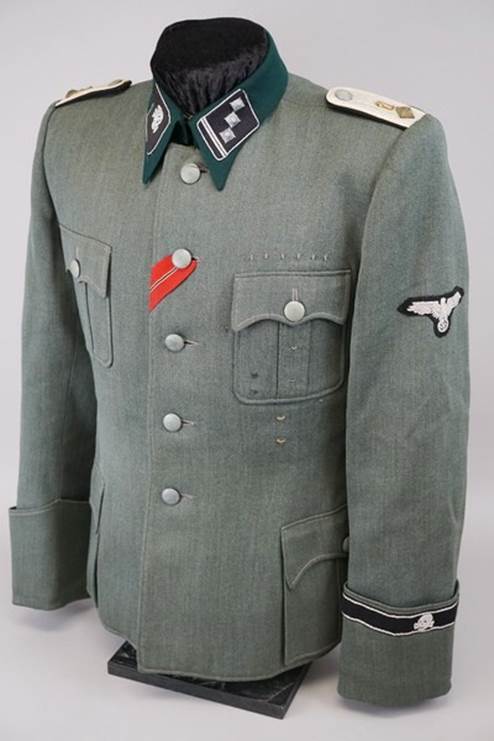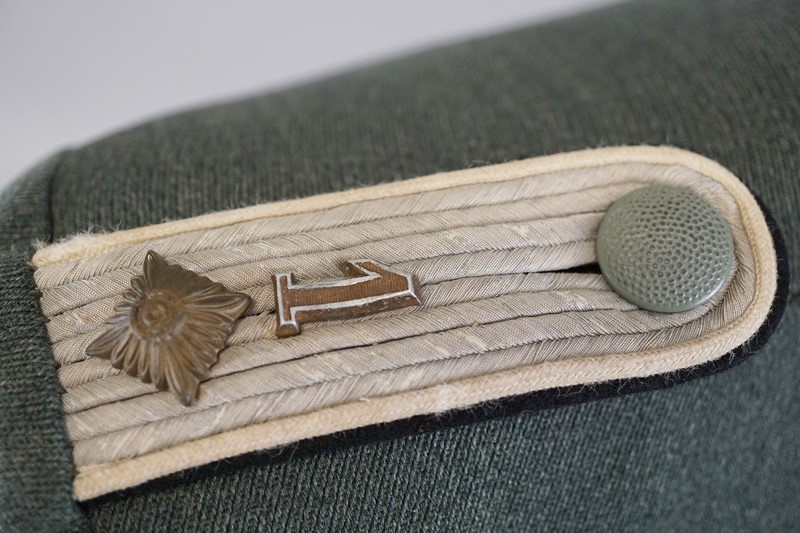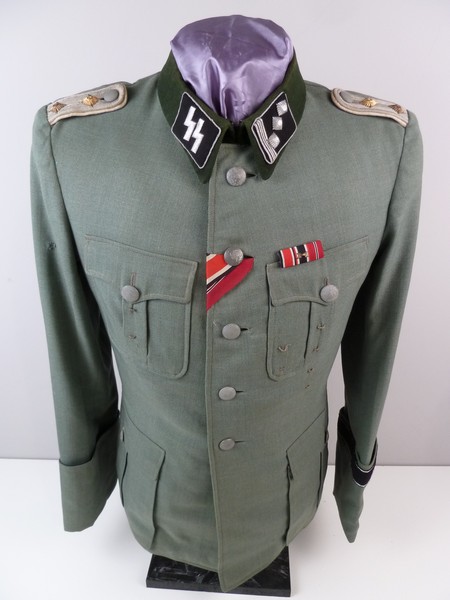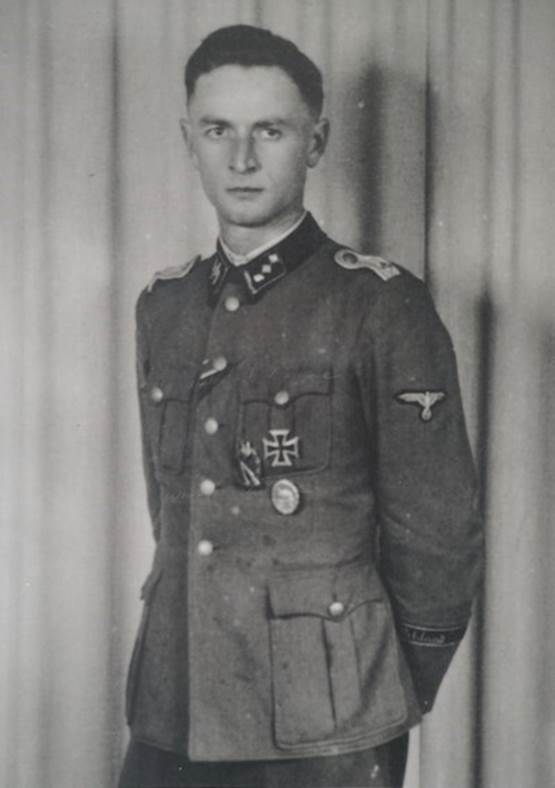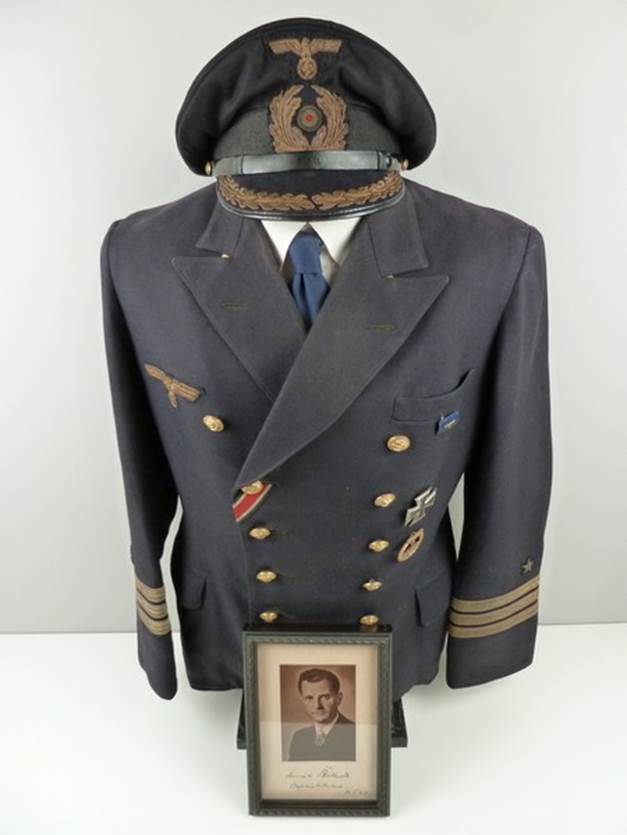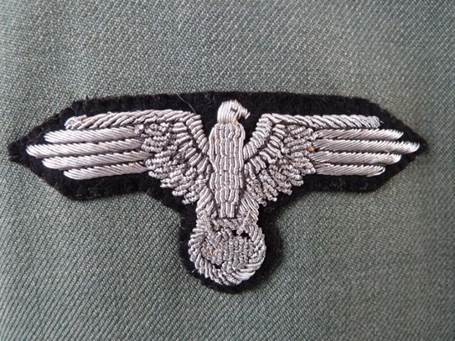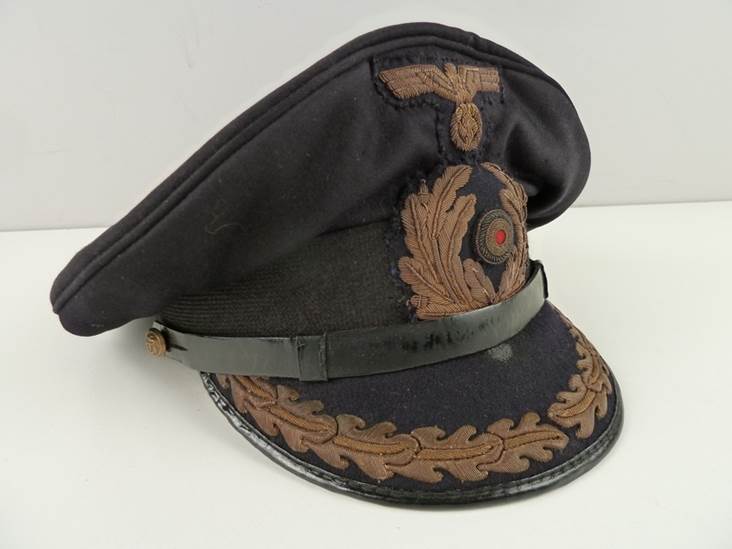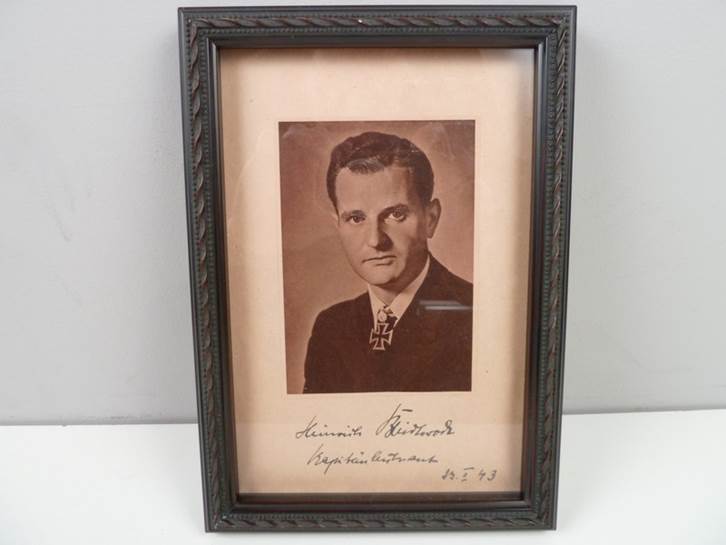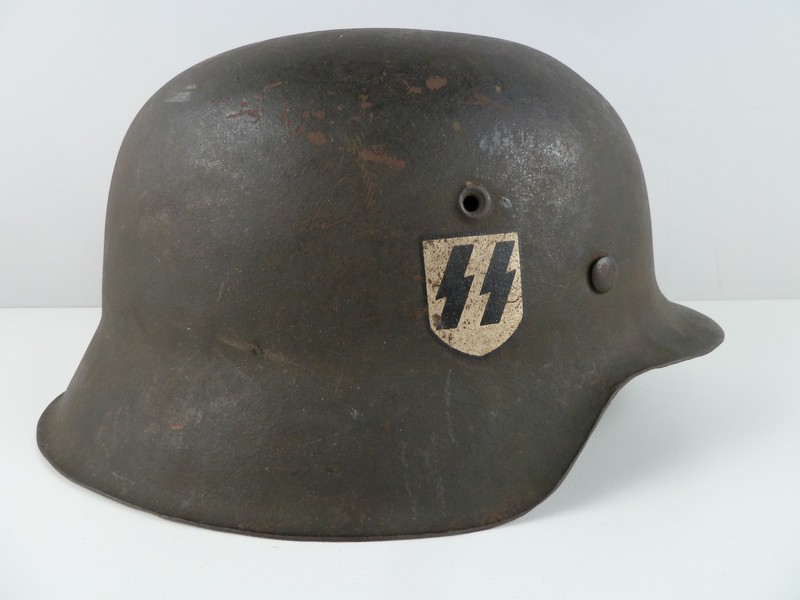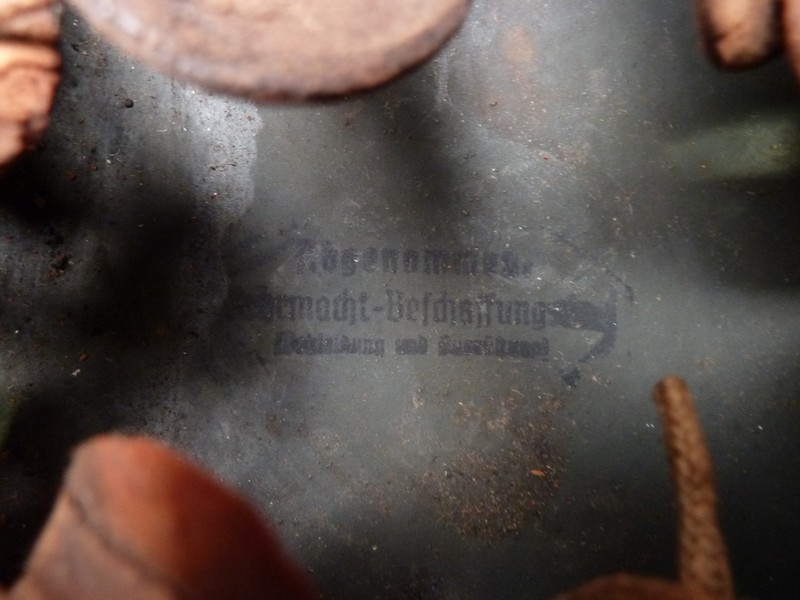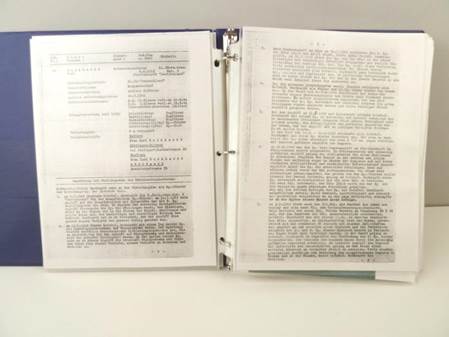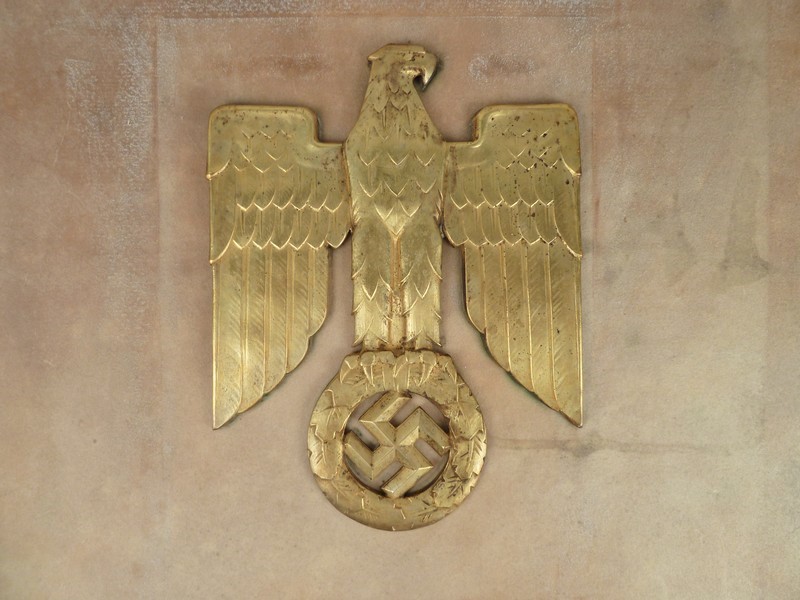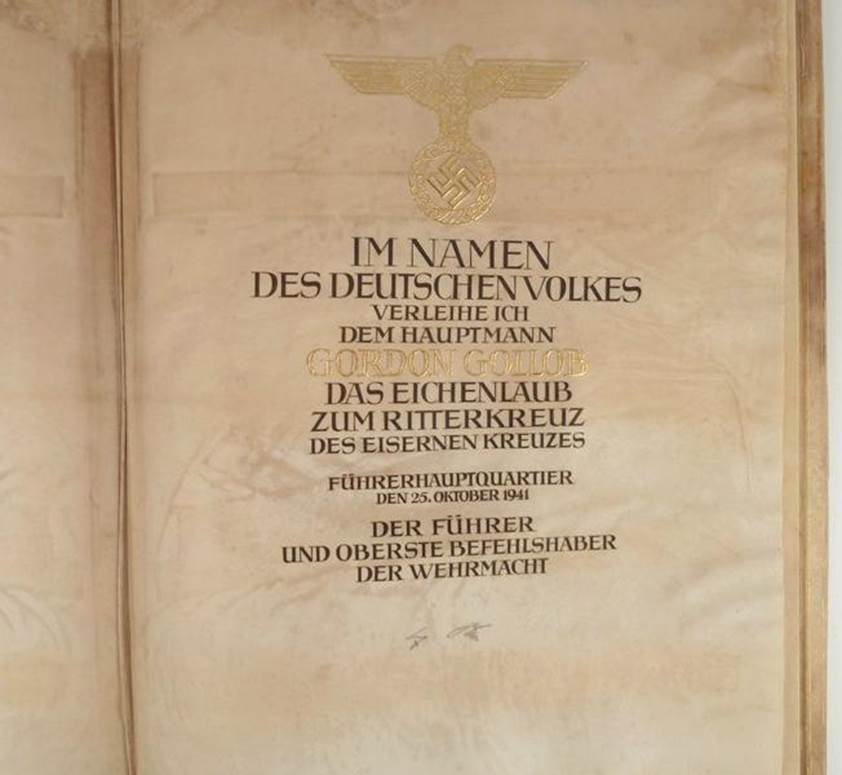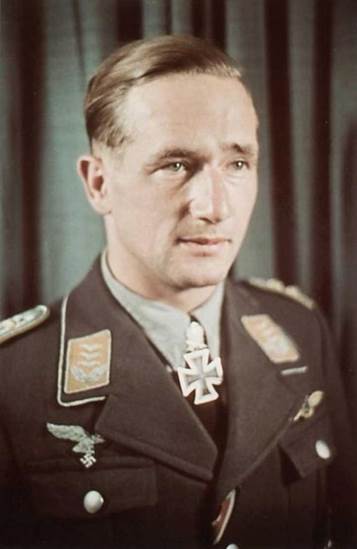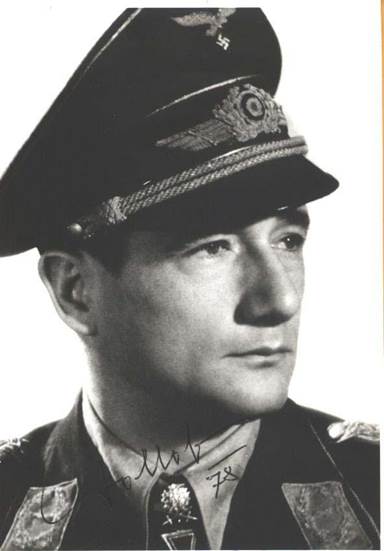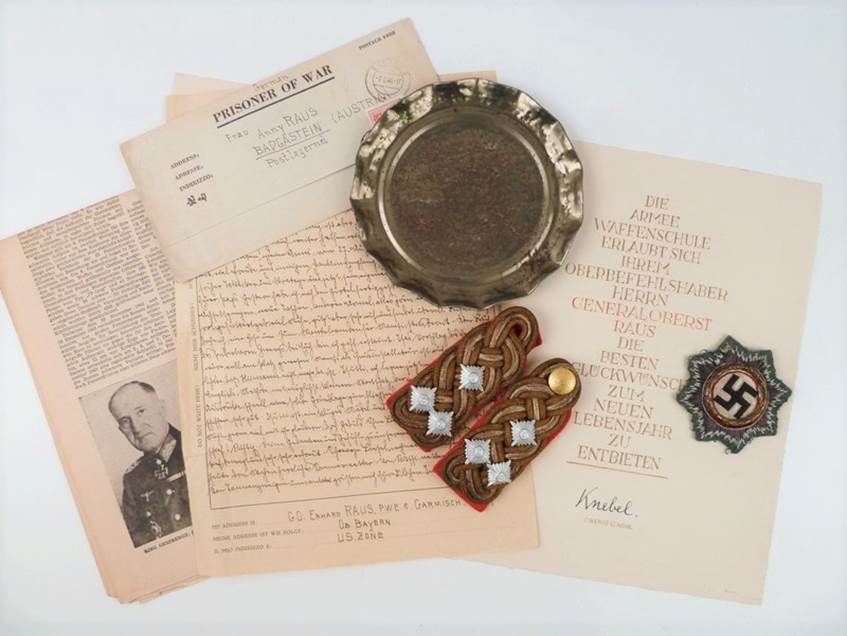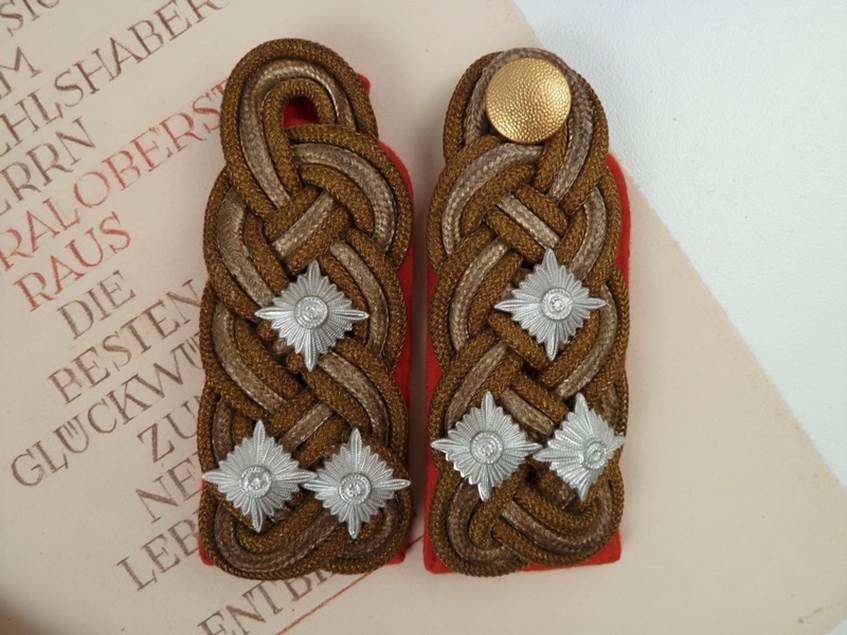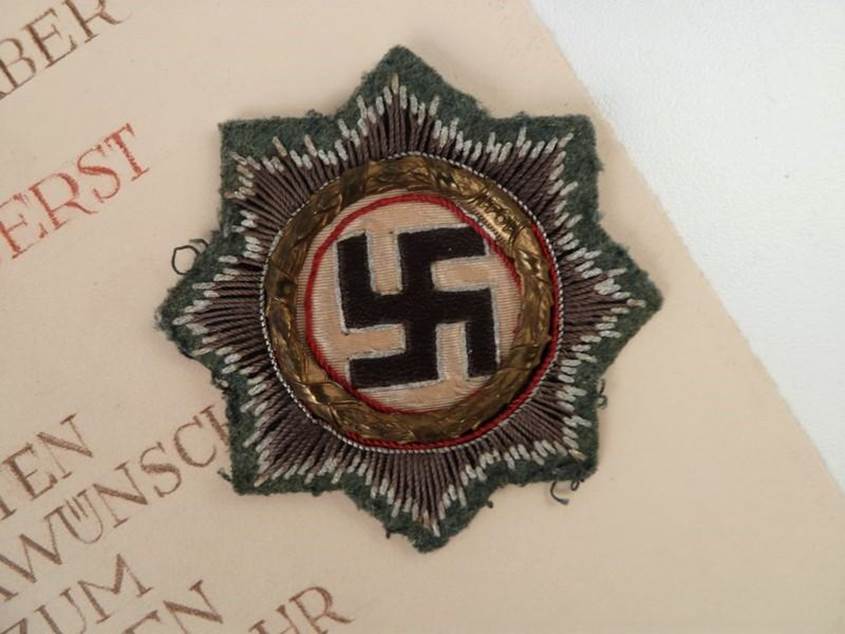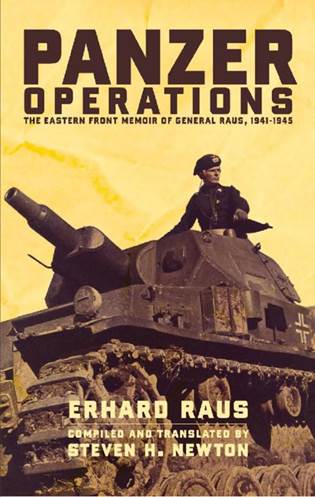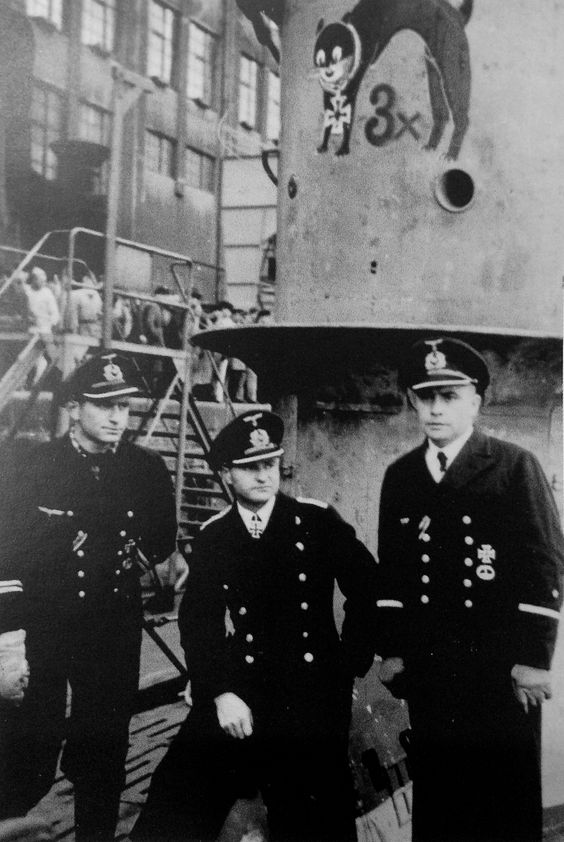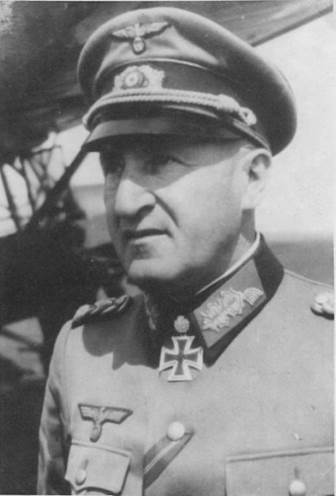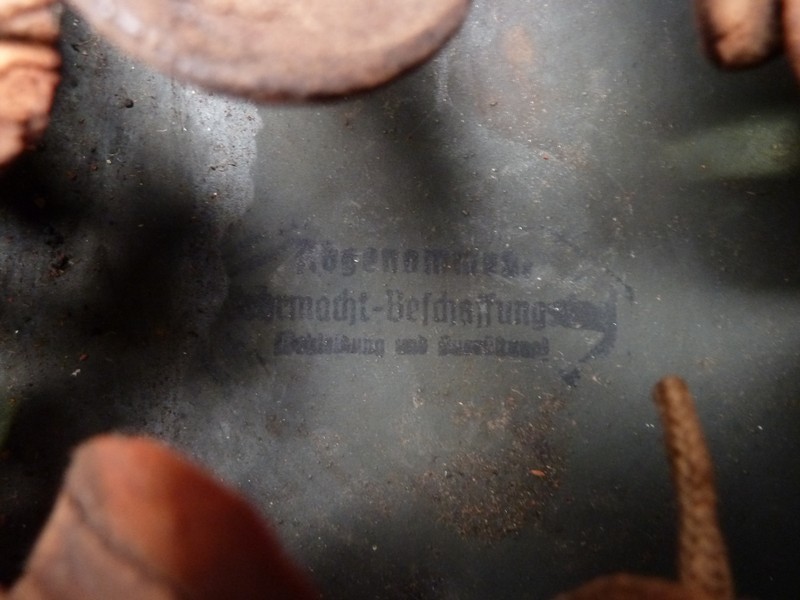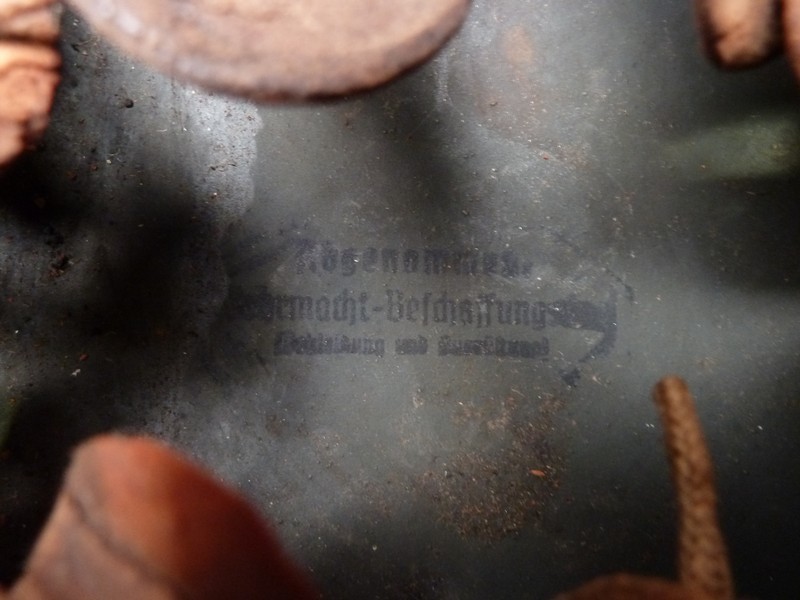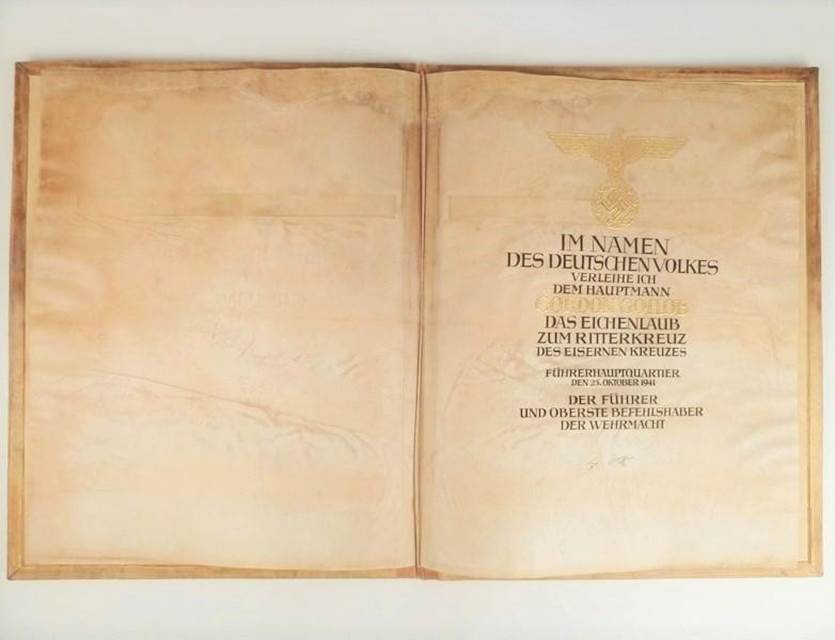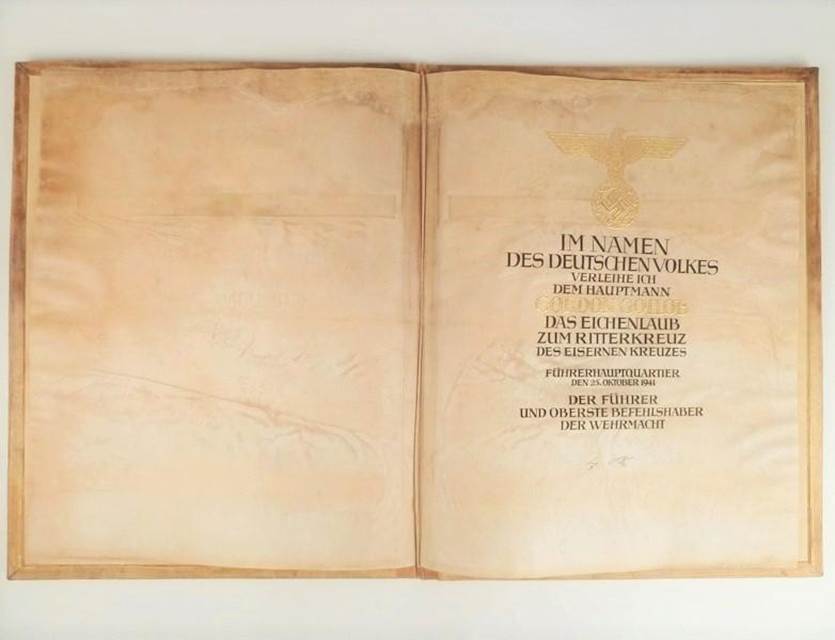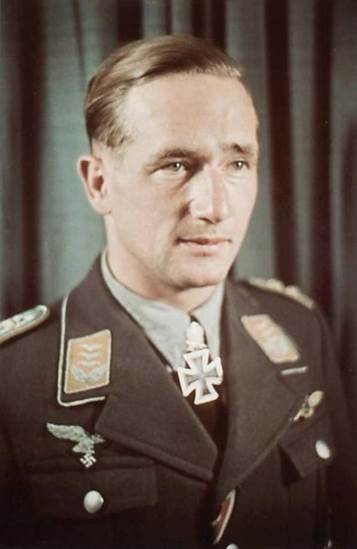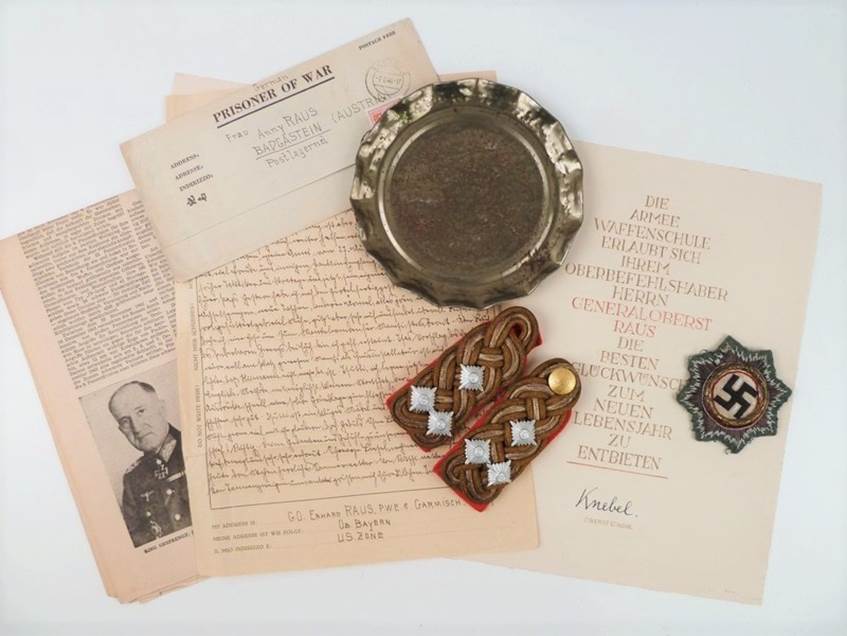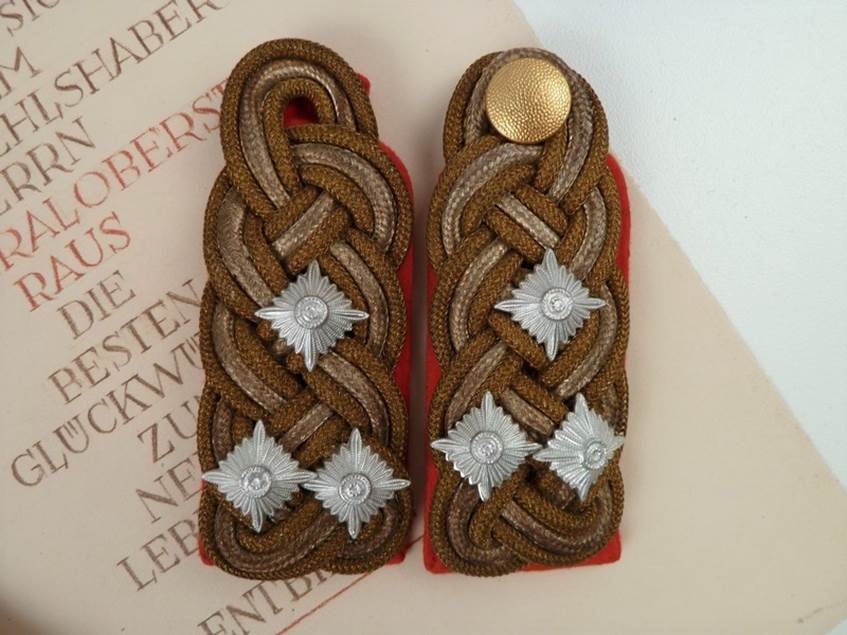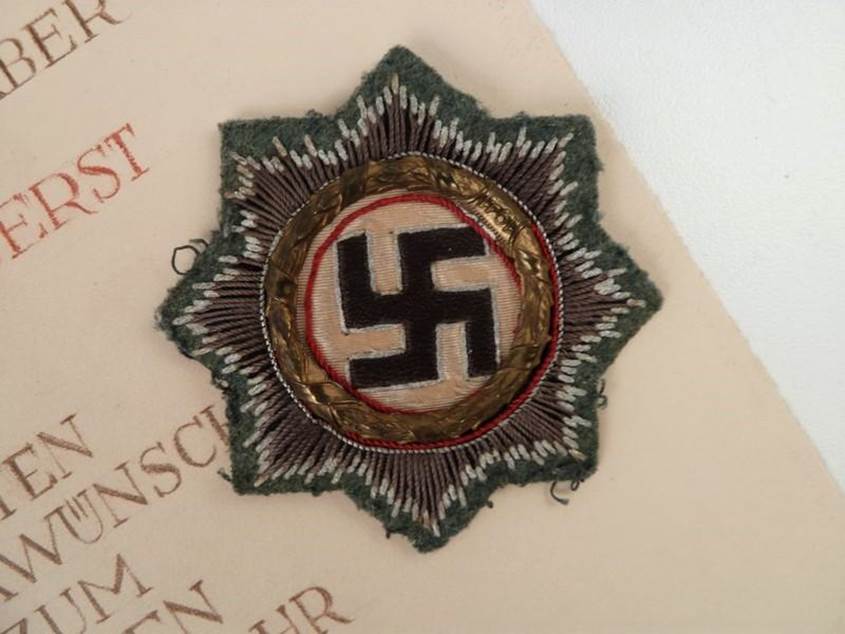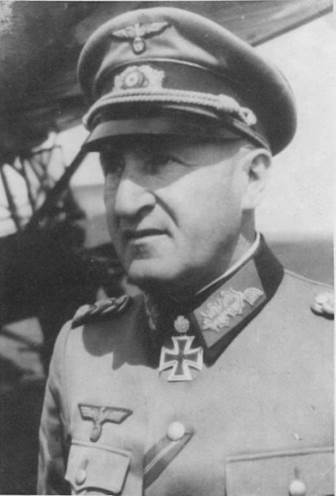Featured Items
|
Welcome to the Featured Items
page, where unique and exotic items that are available for sale (some of
which are in the Premium Militaria section) are explored in detail and for
their historical significance. Most
items exhibited here either have some type of provenance or history of
acquisition, or are of a significance that merit being featured. |
If you would like more information and are interested in acquiring any of
these interesting pieces of history, please contact me.
October 3, 2025
UPDATE
Luftwaffe Ace Walter Hoeckner Uniform
Currently Available
|
|
|
|
|
|
|
|
|
|
|
|
|
Luft JG2 Aces Walter Hoeckner (left) and Walter Oesau February of 1944 |
|
Description: Update 10/19/25 – Consignor found
the pants that came with the uniform and has now supplied me with those and
the boots, which have all been added to the grouping. The uniform grouping consists of a tunic, sweater and visor cap. Boots are also available but not depicted.
The tunic is French-tailored of very high-quality blue-grey tricot wool with
the collar piped in silver-aluminum twist cord. Insignia is for the rank of Leutnant and consists of silver-aluminum cord shoulderboards and embroidered collar tabs, both backed
in a golden-yellow branch color for flight operations. There is an EKII
ribbon at the top buttonhole and loops for two awards on the left breast pocket.
The lining is a high-quality ribbed rayon and has a label from the French
tailor A. Martineau of Marseille. The
sweater is a Luftwaffe issue blue-grey woven wool turtle-neck
with a size tag sewn at the rear inside neck, some small stains at the front
upper chest area. Accompanying the uniform is a beautiful officers
visor cap manufacturer marked to the firm Carl Halfar
in a blue-grey fine doeskin wool (rather than regulation tricot), with
printed name “W HOECKNER” on the underside of the leather sweatband. Pants are blue-grey breeches of fine, ribbed
wool with a four-button hidden fly, slash side pockets with buttons and a
single button back pocket. The inside waist area has faint, blue ink markings
that are illegible. Completing the uniform is a pair of tall, black leather
boots. The consignor reports that originally they
had the remains of Hoeckner’s name printed on the
inside, but that now has faded to being illegible. Leather treatment had been
added in the past in hopes of restoring some of the lettering but
unfortunately has made it worse. Additional photos and price are available upon request. |
|
Background: The following notes regarding acquisition are provided by my consignor; I purchased the grouping
out of an auction in Upstate New York in the late 1990’s (newspaper auction
announcement enclosed). The sale
included the inventory of an antique store that was going out of business. The grouping was from the estate of a
retired career US Army officer and in addition to this officer’s complete
grouping of all of his uniforms from WW2 through the
Vietnam era (also noted in the auction advertisement) was a complete WW2
Luftwaffe uniform. This officer must
have obtained the grouping sometime while stationed in Germany after the
war. There were some other articles of
clothing that went with the uniform but, since each piece was auctioned
separately, I did not obtain all of the items. The visor is a very nice issue Carl Halfar
Verkaufs-Abteilung der Luftwaffe Berlin piece with
the pilot’s name stamped with a rubber ink stamp on the underside of the
sweatband, somewhat faded but readable. The uniform, tailor made in
Marseille, France, also had a very faint ink initials (WH) in the top inside
of the jacket which was very faint when I received it and now is barely
visible. There were a pair of Luftwaffe boots, also with his name stamped
inside, but now the leather has dried out and again is barely legible. At the right angle you can see W. Hoeckner. There was a blue ribbed sweater typical of what
was worn by many pilots. The uniform
is untouched in that all the insignia on the visor and uniform are original
to the period and nothing has been resewn or replaced. Obviously, a well-made tailor piece from
the period. Hoeckner
must have had it tailored for him while he was Leutnant
sometime during the almost two years he was stationed in France. The uniform has been in my possession since
the acquisition for over the last 28 years.
Walter Hoeckner is the only officer with the initials W. Hoeckner (sometimes spelled with an umlaut over the O) in
the Luftwaffe during WW2, which can be verified online at the following site,
which lists all Luftwaffe officers that served during the entire war. https://www.ww2.dk/lwoffz.html
|
|
History: Walter Hoeckner Born: Oct. 24, 1914 in Berlin, Germany Died: Aug. 25, 1944 in Ziegenhain, Germany Knights Cross of
the Iron Cross, April 6, 1944 German Cross in
Gold, July 2, 1942 Assigned to JG/52
and later to JG/77, stationed in France, from August 1940 up until the
Invasion of Russia (June 1941). In
January 1943 transferred to JG/26, still serving in the East. In June 1943 assigned as Kommandeur II./JG1 for the “Reichsverteidigung” (Defense of the Reich), where he was
awarded his Knights Cross (April 6,1944) after 65 victories. In February 1944 he was transferred to
Italy where he served as Kommandeur of 1.JG/4, where he raised his total victory score to 68. On
August 8, 1944 he was killed in an accident on
takeoff in his ME-109G in Ziegenhaim, Germany. His
final officer rank at the time of death was Major. Total Victories: 68 in over 500 sorties, 16 of them in the West with at least 6 four-engine bombers (B-17). A detailed list of all 68 of Hoeckner’s air victories is available at this link; Walter Hoeckner - Pilot Profile - Walter Hoeckner |
Leutnant Kurt Bitter “Grossdeutschland/Führerhauptquartier” Uniform
Currently Available
|
|
|
|
|
|
|
|
|
|
|
|
|
Description: A black panzer feldjacke (wrapper) with white piped collar tabs, shoulderboards of brite aluminum
cord over white backing with single gold rank pips and gold “GD” device, an
enlisted style breast eagle, “Grossdeutschland” cufftitle sewn to the right sleeve, a removable (for
security purposes) “Fuhrerhauptquartier” cufftitle on the left sleeve, and the original medals
(Iron Cross 1st Class, Infantry Assault Badge and Black Wound
Badge). Also included as part of the uniform grouping are black wool panzer
trousers, a pair of ankle boots, belt and holster and field-grey officer
visor cap piped in white with the name “Kurt Bitter” inside the sweatshield. Accompanying the uniform is a
grouping of documents to include; Award documents
for the Iron Cross 2nd Class, the Infantry Assault Badge and the
Black Wound Badge. Personnel and Command Lists for the Fuhrer Hauptquartier, a housing list for the inner security
perimeter with guest names (Bormann, Brandt, Hoffmann, Keitel, Puttkamer, Wolff, etc.) and other documents relating to Feldpost correspondence. Additional photos and price are available upon request. |
|
Background: The panzer officer, Leutnant Karl Bitter, was in the Grossdeutschland
Division and a member of the Fuhrer’s “Fuhrerhauptquartier”
security unit. The uniform was originally
discovered by militaria dealer and author Bill Shea and is featured in his
multi-volume book series, The Stories Behind The
Treasure of World War Two “The Making of a Collectorholic”. According to Shea, this uniform
grouping was offered to him by one of his regular pickers in Germany who had
picked it up “indirectly from the family”.
The grouping included the officer’s black wrapper with original
medals, black panzer trousers, boots, field-grey visor cap and a group of
documents pertaining to his service at the Fuhrer’s
Headquarters. |
SS-Obersturmfuhrer Fritz Reuter
Uniform
Current Availability – SOLD
|
|
|
|
|
|
|
|
|
|
|
Description: A uniform consisting of a
black tricot wool tunic, privately tailored by the Munich tailor “Michels”,
piped in aluminum twist cord around the collar and two pair of pants; black
tricot long pants piped in white and black wool riding breeches with lace ties.
The tunic has officer quality insignia to include a runic tab with numeral
“1”, rank tab and single shoulderboard for an SS-Obersturmfuhrer, a “Deutschland” embroidered cufftitle, a honor chevron for Old Fighters, a
silver-aluminum aiguilette and an SS party armband. Also included are two
awards original to the tunic, the SA Sports Badge and DRL Sports Badge. Overall condition is excellent showing
minor service wear. This uniform is
featured on page 194 of “Meine Here Heiβt Treue: Inside The Allgemeine SS 1925-1945”
by Ulrich of England. Additional photos and price
are available upon request. |
|
Background: This uniform is part of a
large grouping of material belonging to SS-Obersturmfuhrer
Fritz Reuter that was purchased directly from the Reuter family estate by a
Belgium collector who befriended family members (if interested, please contact me as I have further details and names that can be disclosed privately). In addition to this uniform
and two pair of pants, the following other Reuter items were also acquired as
part of the grouping and have been absorbed into collections or have been for
sale via various militaria dealers and auction houses. These include; Officer Visor Cap, black
riding breeches with zippers, black service boots, brocade belt, buckle and
aiguilette in storage box, officer leather belt and buckle, NCO buckle,
personal photo albums, a binder of original documents and promotions, many
signed by Himmler, a kepi with original rain cover, a black greatcoat, SS
Honor ring, SS officer sword, Teno officer insignia and WWI medals from
Reuter’s father. |
|
History: Name: Fritz Reuter Joined Allgemeine SS 1933 Bad Tolz 1936 SS Class Ranks: Standartenjunker September 1, 1936 Standartenoberjunker February 16, 1937 Untersturmfuhrer – April 20, 1937 Leutnant der Schutzpolizei
– April 20, 1937 Obersturmfuhrer – November 9, 1938 Oberleutnant der Schutzpolizei
– November 9, 1935 Haupsturmfuhrer Hauptmann der Schutzpolizei Participated in the SS/Heer exchange program Served in the Heer Polish Campaign, September 1939 Regimental Ordance Officer, Infanterie Regiment 85, 10.Infanterie
Division Zugfuhrer 11. Kompanie Chef 10. Kompanie Transferred to Polizei Division
January 4, 1940 Kompanie Chef 3.Kompanie of the Ersatz Batallion
of Polizei-Schutzen-Regiment
3 Killed in action while commander by a direct artillery hit on
detachment headquarters, August 2, 1942, near Sablinow,
Russia. Awards: Iron Cross 2nd Class – September 20, 1939 Iron Cross 1st Class – November 19, 1940 Infantry Assault Badge – November 1, 1941 German Cross in Gold - May 13, 1942 There is a biographical profile of Fritz Reuter in the book “German
Cross in Gold Holders of the SS & Police, Volume 6” by Mark Yerger,
on pages 100 – 104, describing in detail the combat actions and command
leadership that earned Reuter the German Cross in Gold. Contact for these details if you don’t have the book and are interested. |
Konteradmiral Karl-Jesko von Puttkamer White Summer Tunic
Update: SOLD
|
|
|
|
|
Description: White cotton twill summer
tunic with removable insignia, named to Admiral von Puttkamer
in absolute pristine condition. The shoulderboards were carefully stored off the uniform in
an envelope and look almost brand new as the bullion has very slight toning
and is nice and bright. The breast
eagle is also stunning and is removable as well. This is one of the cleanest white summer
tunics I’ve ever encountered. |
|
Background: This white tunic is part of a
grouping of four uniforms (white tunic, frock coat, blue reefer jacket,
leather overcoat) that were acquired directly from Admiral Puttkamer by the late collector Bill McClure. If you are not familiar with McClure, he
was one of the early pioneer collectors who contacted many of the Generals,
Field Marshals, Admirals, etc. while they were still alive back in the 1960’s
and 1970’s and bought the uniforms directly from these well-known
officers. As a result, there are now a number of fully provenanced personality uniforms sitting
in collections throughout the world, some of which occasionally re-enter the
market after decades of not being seen.
This tunic is fully provenanced and includes copies of a large
quantity of documents, letters and signed photos as well as provenance
(letters from Puttkamer to McClure stating that he
sold his personal uniforms to McClure and a letter from McClure to the first
collector who bought the grouping).
Since Puttkamer sold this grouping to McClure
in 1970, there have only been two other owners. You will also find all of
these uniforms featured in the Angolia/Schlicht
reference book series “Uniforms and Traditions of the Kriegsmarine”. I cannot stress enough how rare it is to
find a grouping that is this well documented with provenance and having only
been in two collections since the 1970’s.
The current owner is keeping half of the grouping (a blue reefer
jacket and leather greatcoat).
Photocopies of all provenance documents, photos and letters will be
provided with this grouping, the owner will retain the originals. |
|
History: Konteradmiral von Puttkamer
is most well known in collector and historian circles as being Hitler’s Naval
adjutant and for having been wounded in the July 20, 1944 attempt on Hitler’s
life by Oberst Claus von Stauffenberg.
As the Fuhrer’s adjutant, Puttkamer was
constantly at Hitler’s side and is well-documented in period publicity
photos, many of which he can be seen wearing the four uniforms that made up
this original grouping. |
|
|
|
Hitler visiting Puttkamer in the hospital as he recovers his wounds from
the July 20 bomb blast assassination attempt. |
|
|
|
July 1944, at the Wolfschanze just prior to the assassination attempt. At
the immediate left is Oberst von Stauffenberg, the officer who placed the
bomb underneath the table in the attempt to kill Hitler. Just to the right of
Stauffenberg, facing the camera is Admiral von Puttkamer. |
|
|
|
A signed photo of Puttkamer in the white tunic next to the Fuhrer train
(part of the grouping of photos that came with the uniforms). |
Waffen-SS Totenkopf Standarte Oberbayern Obersturmfuhrer
Officer Tunic
Update:
SOLD
|
|
|
|
|
|
|
|
|
|
|
|
|
|
|
Description: Tailor-made model 39/40 officer tunic in a high-grade field-grey tricot
wool, five button front panel with scalloped and pleated patch pockets,
bottle green collar and silver-grey rayon lining. The tunic features a very
rare machine-woven officer Totenkopf collar tab, an Oberbayern
hand-embroidered Totenkopf cufftitle, a
high-quality variant hand-embroidered officer sleeve eagle and shoulderboards with a numeral “1” cipher. |
|
Background: This tunic just came out of collection in which it has resided for 43
years. It was originally obtained by Andrew
Mollo, the well-known SS and uniform expert, author and historical film
consultant (as well as producer). Mr.
Mollo authored many of the first available reference books on SS uniforms and
has authored militaria reference books since the 1960’s. This same tunic is also featured in the
Michael Beaver series of books “Uniforms of the Waffen-SS, Volume I” on pages
265 – 269 and is on the cover of the book by Jost W. Schneider “Their Honor
Was Loyalty!”. |
|
History: When SS men transferred over into the Waffen SS from the Allgemeine SS,
they often transferred their traditional insignia to their new uniforms, as
is the case with this particular example in which the “1” cipher and the
skull cufftitle have carried over. |
If you would like more information and are interested in acquiring this
interesting piece of history, please contact me.
May 8, 2018 Update
Waffen SS Hauptsturmfuhrer of
“Deutschland” Karl Burkhardt Tunic and Documentation Portfolio
Update: This item is currently SOLD
|
|
|
|
|
|
|
|
|
|
|
|
|
|
|
|
|
|
|
|
|
|
Description: Field grey, M40 style tailor-made officers tunic made from a fine grade,
lightweight whipcord material with a five button front, scalloped and pleated
pockets and French cuffs. There are loops on the right breast for a DKiG award and three sets of loops on the left breast for
combat awards. Above the left breast
pocket is a small ribbon bar and EKII and Russian Front ribbons are sewn to
the buttonhole on the front panel.
Insignia consists of piped runic and rank tabs, a pair of shoulderboards each with two gold pips attached (one of
the pips on each board is a brighter gold, indicating a later addition when
rank was upgraded), a hand-embroidered officer quality sleeve eagle and an
officer quality flatwire embroidered “Deutschland” cufftitle. The
tunic shows a modest amount of even wear (including some small abrasion on
the inside of the cuffs) and the condition of the tunic is in overall very
good to excellent condition with one snag on the upper right sleeve. There is a tailor tag on the lining by the
inside pocket and a matching name tag (with the officers name) on the inside
of the pocket. |
|
|
Background: The tunic and document portfolio have become available from a large
advanced SS collection in the Western United States that was recently
dissolved. The documents and research
appear to have been done by an earlier owner in the Midwest. |
|
|
History: The tunic has been fully researched by a previous owner and is
accompanied by a binder featuring over 70 pages of historical research on SS Hauptsturmfuhrer Karl Burkhardt, whom the tunic is named
to. Burkhardt was a veteran combat
officer who commanded multiple companies in Deutschland on the Russian front from early 1941 until January of
1945 when he was transferred to Hohenstaufen. Commanding infantry companies and panzer
grenadier regiments, Burkhardt was wounded numerous times and was awarded the
German Cross in Gold, EKI and EKII, the Wound Badge in both Black and Silver,
the Infantry Assault Badge in Bronze, the Army Roll of Honor Clasp-1945 and
the Eastern Front Medal. After being wounded four times, Burkhardt was killed
leading his Hohenstaufen battalion near Sarcestur
on March 13, 1945. The document
portfolio accompanying the tunic contains research from various archives
(NSDAP Membership Files, SS Officer Files, Race and Settlement (RuSha) Files and SS Enlisted Men Files) including his Lebenslauf, personnel file, telegrams, official
documents, photos of him and his wife and contemporary letters to various
institutions requesting information. |
|
|
SS Hauptsturmfuhrer Karl Burkhardt |
|
|
|
|
October 19, 2017 Update
U-Boat Commander Heinrich Bleichrodt Jacket & Visor Cap
Update:
This item is SOLD
|
|
|
|
|
|
|
|
|
|
|
Description: Dark navy blue reefer jacket made from a very high quality, twill
gabardine wool weave by the tailor J. Robrecht (Hans Thiele) in Kiel, which
of course was the harbor for many U-Boat flotilla’s as well as their training
and manufacture. The jacket features a
gold bullion hand-embroidered breast eagle, bullion sleeve rank stripes for
the rank of Korvettenkapitan and Bleichrodt’s original awards (EKI screwback
and Submarine War Badge) and ribbons.
The visor cap is a fixed blue-top made from a doeskin wool and has the
initials “H” and “B” in metal affixed to the interior sweatband. The cap shows regular wear from many years
of us with some repairs to the sweatband, an upgraded visor with oakleaves
attached when elevated in rank and the original eagle reattached from de-nazification. Also accompanying the grouping is a
wartime signed photo of Bleichrodt in a frame. |
|
Background: This jacket, visor and photo were obtained from Bleichrodt’s
son in the late 1970’s by a well-known (at the time) Kriegsmarine
collector. In the 1980’s he then sold
this grouping to the current owner. Both the reefer jacket and visor cap are
featured in the reference book series “Uniforms
& Traditions of the Kriegsmarine; Volume 1” by Angolia
and Schlicht and can be viewed on pages 344 & 345. There are also numerous pictures that can
be easily found with a Google search of Bleichrodt
wearing this exact same jacket. |
|
History: Heinrich Bleichrodt was a recipient of the Oakleaves to the Knights Cross of the Iron Cross and the Submarine War Badge with Diamonds. He
was one of the most successful U-Boat Commanders of the second World War,
commanding U-48, U-67 and U-109, sinking 24 ships and registering one of the
highest tonnages sunk during the war.
His sinking of the “City of Benares”, an un-marked evacuation ship
that went down with 90 children onboard, generated some controversy and led
to a war crimes trial at which he was acquitted. In late 1942 Bleichrodt
had a breakdown while at sea and relieved himself of command. He spent the next two years in the U-Boat
training division at Kiel as tactical instructor for officers until July of
1944 when he was appointed Chief of the 22nd U-Boat Flotilla. Bleichrodt lived
until January of 1977, when he passed away in Munich at the age of 67. |
|
On the deck of the U-48; Commander Bleichrodt
(center), Teddy Suhren (left) and Erich Zurn
(right). |
|
|
|
Heinrich Bleichrodt wearing this same reefer jacket. Notice how the EKI is tilted slightly to
the right….this is because it is a screwback award
and easily turns in either direction, as it still does today. The visor cap is a different on and
reflects an earlier rank. |
|
|
|
Below a photo of the cover of the book “U-48 The Most Successful U-Boat of the Second World War” by
Franz Kurowski, which documents the history of the U-48. Bleichrodt
commanded two patrols on U-48, one of which resulted in the sinking of the
“City of Benares”. |
|
|
May 10, 2017 Update
Waffen SS M42 Double Decal Helmet
Update: SOLD
|
|
|
|
|
|
|
|
|
|
|
|
|
Description: M42 pattern ckL produced helmet featuring
double decals (SS runes on the right side, party decal on the left side),
well worn with an intact liner but missing the chin strap. The helmet shell
is a large size 70. |
|
|
Background: This helmet originated out of an old collection of which the current
owner spent 35 years in pursuit. The
goal was to collect size 70 shells from all of the branches of service, a
quest the current owner has now given up! |
|
|
History: The Waffen SS stopped the use of decals on helmets 18 months after the
issue of M42 style helmets, so it is incredibly rare to find an M42 with
double decals and many that have been encountered are re-issue that were
found in use by a variety of units (everything from Normandy defenses to
Foreign units and concentration camp personnel). |
|
If you would like more information and are interested in acquiring this
interesting piece of history, please contact me.
March 15, 2017 Update
Luftwaffe Ace Gordon Gollob’s Formal Oakleaves Document
Available!
|
|
|
|
|
|
|
|
|
|
|
|
|
Description: Standard pattern formal award mappe and
document for The Oakleaves To The Knights Cross Of The Iron Cross that was
awarded to Gordon Gollob. The formal
document is a large double paged parchment with the right facing side showing
the award description and award date in black-brown ink calligraphy with the recipients name in raised genuine gold leaf letters. The national emblem of the eagle &
swastika is also finished in gold leaf and at the bottom of the document is
Adolf Hitler’s original ink signature. The outer mappe
(cassette-folder) is an ivory colored velum parchment with a large gold
fire-gilt bronze wehrmacht eagle affixed to the
front cover. The typical gold hand
tooled edges are present as is the small gold “Frieda Thiersch” mark at the
bottom inner page. The mappe cover and document
both show moisture damage which occurred as a result of Gollob’s awards and
documents being buried beneath a barn at the end of the war to protect them
from being looted by the invading Allied troops. |
|
|
Background: This Oakleaves document was part of the large grouping of Gollob’s
awards and documents that were purchased from the Gollob family several
decades ago. Included in this grouping were all of Gollob’s consecutive
Knights Cross awards and formal documents to include his Knights Cross of the
Iron Cross with Oakleaves, Swords & Diamonds. It was an amazing grouping, the likes of
which may never be seen again. |
|
|
History: Gordon Gollob was one of the top fighter ace’s
in the Luftwaffe during WWII, having downed 150 enemy aircraft in over 340
missions, most of his action coming on the Eastern front against the
Russians. His first victory was on
September 5, 1939 in Poland just days after the start of the second World
War. Gollob was removed from aerial combat missions in October of 1942 over
concerns he would be shot down and spent the remainder of the war first
commanding fighters and then acting as inspector. Gollob survived the war and went on to lead
a long life, passing away in September of 1987 at the age of 75. |
|
|
|
|
If you would like more information and are interested in acquiring this
interesting piece of history, please contact me.
March 7, 2017 Update
Generaloberst Erhard Raus’ Shoulderboards Grouping
Update: SOLD
|
|
|
|
|
|
|
|
|
|
Description: A personality grouping belonging to Generaloberst
Erhard Raus, to include; Generaloberst shoulderboards, cloth German Cross in Gold, two letters
to Raus from his wife while a POW, new years wishes
to Raus from the Army School he commanded. Standard pattern General officer shoulderboards consisting of gold & silver interwoven
cords with four bends on the side and a button loop at the top. Bright red
(branch color for Heer Generals) underlay of badge cloth with tongues
attached (slip-on style) for use in removable board applications. These boards have the
much less often encountered basketweave style of embroidery of the
inner silver cords (more typically these silver braid
are seen in the soutache style). Three
aluminum rank pips are positioned in the diamond style pattern of two side by
side pips at the base of the board with a single pip centered directly above
indicating the rank of Generaloberst (equivalent to
a four star General). The boards
exhibit a moderate amount of use and age toning to the silver and gold but
are in very good to excellent condition.
A single screw post shoulder button in pebbled gold is affixed to the
left shoulder position shoulderboard. Generaloberst is
one of the more difficult and rare ranks for the collector to find, as few
men attained this rank. In the German army (Heer) there were a total of 55
men promoted to this rank, a third of these Generaloberst,
18 men, eventually became Field Marshal.
Cloth German Cross in Gold on field grey backing, removed from the
uniform of Raus and in very good condition showing age and use. Two letters from the wife of Raus addressed
to him as a POW in Badgastein, Austria with
envelopes and a formal document to Raus from the Army School that Raus
commanded, expressing new years wishes to him. |
|
|
Background: This small grouping was recently separated from a larger grouping of
material attributed to Erhard Raus and obtained from his family that has
circulated amongst several collectors and dealers. Included in this large
grouping was an abundance of his insignia to include three pair of Generaloberst shoulderboards
(including this pair), three single General officer collar tabs (of a very
unique and unusual design, yet documented in period photos of him), a gold
bullion breast eagle, his greatcoat with red lapels and Generaloberst
shoulderboards, his visor chin cords and most of
his medals and awards to include several worn specimens of the German Cross
in Gold. Photos of the grouping are
available to potential buyers. |
|
|
History: Generaloberst Erhard Raus is most well known
for his role as commander of the 6th Panzer Division as it drove
through Russia during Operation Barbarossa.
Raus was known as a brilliant frontline tactician capable not only of assault
but more so for his defensive abilities, via timely and skillful withdrawals
of troops with minimal losses through the unique creation of his “zone
defense”. After the war Erhard Raus authored the book “Panzer Operations: The Eastern Front Memoir of General Raus
1941-1945” covering his time in the Russian Campaign. General Raus was decorated with the Knights
Cross of the Iron Cross with Oakleaves and the German Cross In Gold. |
|
|
|
|
|
If you would like more information and are interested in acquiring this
interesting piece of history, please contact me. |




















